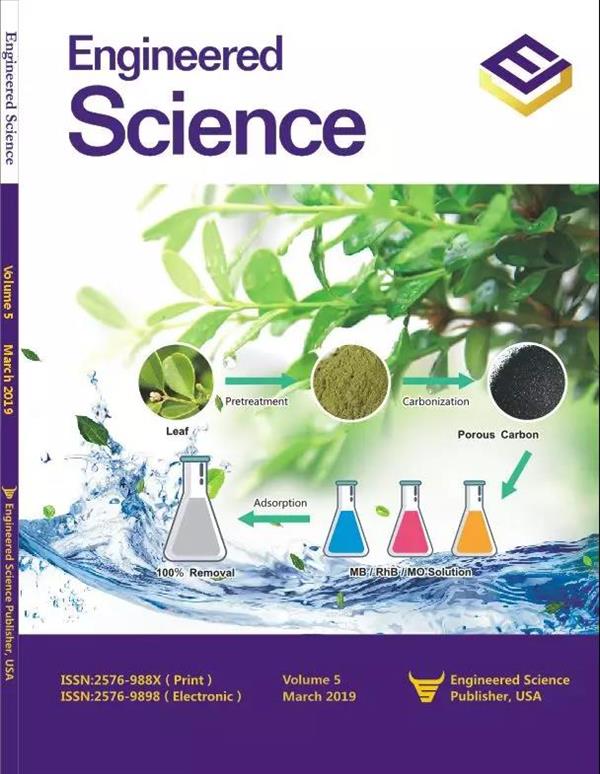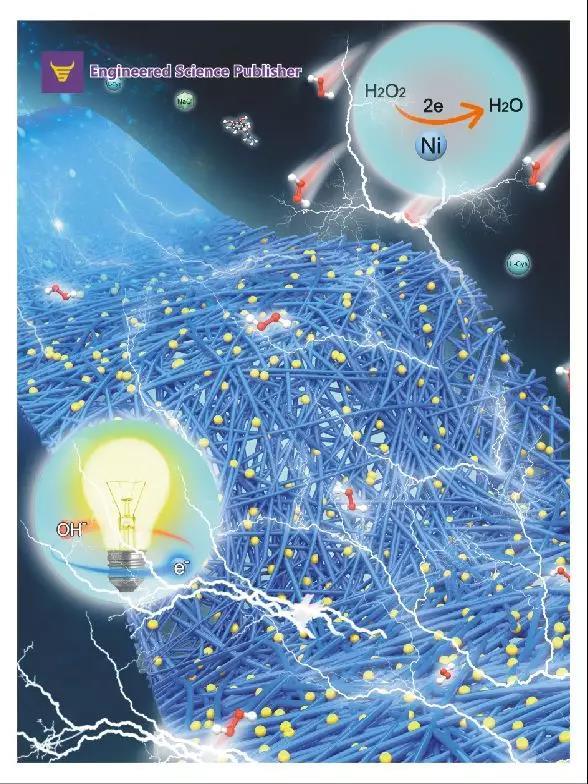Engineered Science期刊第5期论文已正式上线
http://www.espublisher.com/allIssues.html?linkCode=1101&journalId=1&volume=5
敬请各位专家学者多投稿、审稿,多浏览、下载和引用本期刊论文,也敬请您多提宝贵意见,以便我们后期进一步优化和改进本期刊质量,感谢您的大力支持!
Volume 5, February 2019


Nanoparticles in Biomedicine-Focus on Imaging Applications
Peng Zhou, Juping Wang, Xiaohong, Tao Huang, Prakash D. Nallathamby, Lan Yang, Weiwei Zou, Yongchao Zhou, Jean-Michel Jault, Song Chen and Feng Ding
Eng. Sci., 2019, 5, 1–20
DOI:www.doi.org/10.30919/es8d708
Abstract:Over the last two decades, nanotechnology has become one of the most dynamically evolving field of research. Various types of nanoparticles are widely exploited to extend our understanding of biological interactions at the molecular level. They are actively engaged in the biomedical research for imaging, biosensing, drug delivery and/or concurrent therapy. Recent progress on this field is briefly reviewed here with an emphasis placed on the wide imaging applications of nanoparticles. Collectively, this field will no doubt make greater impact after we gradually address any potential risks of nanoparticles.
Robust Construction of Flexible Bacterial Cellulose@Ni(OH)2Paper: Toward High Capacitance and Sensitive H2O2 Detection
Jie Cai, Wei Xu, Yuheng Liu, Zhenzhou Zhu, Gang Liu, Wenping Ding, Guozhen Wang, Haibo Wang and Yangchao Luo
Eng. Sci., 2019, 5, 21–29
DOI: 10.30919/es8d669
Abstract: Multifunctional properties, including energy storage and sensitive diagnosis, are highly demanded for high-performance supercapacitors and sensors. Herein, we describe a facile method for the synthesis of a multitasking bacterial cellulose@Ni(OH)2 paper for use as a flexible supercapacitor electrode with excellent energy storage performance and a sensing platform for high-sensitivity detection of H2O2. Monodispersed surfactant-free Ni(OH)2 particles with a large fraction of edge sites were anchored on the cellulose fiber network, providing a bendable, freestanding, and hydrophilic material, and leading to attractive electrochemical properties. As expected, this flexible electrode exhibited a remarkable areal capacitance of ~2047 mF cm-2 and high flexibility allowing it to be bent to arbitrary angles. As a nonenzymatic H2O2 detection electrochemical electrode, it displayed a fast amperometric response with a linear range of 0.1–12.4 mM, acceptable sensitivity (~3.79 uA mM-1 cm-2), and low detection limit (~0.28 μM, S/N=3). The versatility of the electrode can be demonstrated by its high selectivity in the presence of interfering species, good reliable detection, and also its ability to detect H2O2 in real samples. The simple, low-cost, and general strategy presented herein can be extended to the preparation of other biomass materials and open up new opportunities for flexible electronic devices.
Adsorption Removal of Pollutant Dyes in Wastewater by Nitrogen-doped Porous Carbons Derived from Natural Leaves
Jun Chen, Xiaosu Wang, Yan Huang, Shanshan Lv, Xiaohua Cao, Jimmy Yun and Dapeng Cao
Eng. Sci., 2019, 5, 30–38
DOI: 10.30919/es8d666
Abstract: An easy pyrolysis and activation synthesis method has been proposed to convert a common biomass waste of Euonymus japonicus leaves into nitrogen-doped porous carbons (NPCs), and its application in the removal of methylene blue (MB), methylene orange (MO) and rhodamine B (RhB) from simulated wastewater was further explored. The uptake of NPCs for dyes increases along with the initial dye concentration and contact time but decreases with the NPC dosage. The adsorption capacities of the NPCs for MB, RhB and MO were 626.1, 620.7 and 370.8 mg·g-1, respectively, which meant that the NPCs were better adsorbents for cationic dyes (MB and RhB), compared to the anionic dye (MO), because the NPC surfaces carry partial negative charges. In order to elaborate the adsorption mechanism, the kinetics data were analyzed by pseudo-first order, pseudo-second order, intra-particle diffusion and Elovich models, in which the pseudo-second order model exhibited the best fit. The adsorption data were evaluated by Langmuir, Freundlich, Temkin and Dubinin-Radushkevich isotherm models, in which the Langmuir model could well describe the adsorption processes. This study presented a potential alternative low-cost high efficient adsorbent for removing pollutant dyes from wastewater through using biomass waste leaves as sources.
A Systematic Synthetic Study of Polyelectrolyte Nanocapsules via Crystallized Miniemulsion Nanodroplets
Boyang Sun, Haotian Sun, Yukun Li, Honggang Cui and Chong Cheng
Eng. Sci., 2019, 5, 39–45
DOI: 10.30919/es8d536
Abstract: Synthesis of polyelectrolyte nanocapsules (NCs) by interfacial crosslinking of surfactant monolayers adsorbed on crystallized miniemulsion nanodroplets is systematically studied by using surfactants with varied lengths of hydrophobic n-alkyl tails. The results indicate that the n-alkyl tails of surfactants need to possess at least sixteen carbon atoms, in order to obtain stable surfactant monolayers for achieving well-defined NCs. The structural control of NCs via crystallized miniemulsion systems is discussed.
Bio-Inspired Feature-Driven Topology Optimization for Rudder Structure Design
Jihong Zhu, Yubo Zhao, Weihong Zhang, Xiaojun Gu, Tong Gao, Jie Kong, Guanghui Shi, Yingjie Xu and Dongliang Quan
Eng. Sci., 2019, 5, 46–55
DOI: 10.30919/es8d716
Abstract: A fish operculum bone is a high-efficiency load-carrying structure, which transfers the surface pressure of the fluid through the special supporting structures on the thin-walled panel to the joint position connecting the body. In order to bring this concept of bionic structures into the flight vehicle rudder structures’ optimization design, problems such as the structural feature and parameterized modeling, load-carrying behaviors analysis, optimization design method, performance evaluation etc. need to be properly solved. To this end, we studied the operculum structure and found that the properly distributed Y-shape structural branches undertake the surface load perfectly. Meanwhile, the influence of these Y-shape branches distribution was discussed with numerical simulation and topology optimization. By considering the Y-shape branches as a special structural features, the bio-inspired design procedure was then established by integrating the structural layout and sizing parameters as well as their simultaneous feature-driven optimization. We also designed a typical flight vehicle rudder structure and fabricated it with stereolithography based resin additive manufacturing. With more than 20 % improvement in stiffness and strength compared with the traditional design, the advantages of the bio-inspired optimization have been clearly demonstrated.
Functionalization and Fabrication of Soluble Polymers of Intrinsic Microporosity for CO2 Transformation and Uranium Extraction
Anwang Dong, Tingting Dai, Mengyao Ren, Xuemei Zhao, Shilei Zhao, Yihui Yuan, Qi Chen and Ning Wang
Eng. Sci., 2019, 5, 56–65
DOI: 10.30919/es8d613
Abstract: Task-specific porous polymer PIM-1-based quaternary ammonium iodide (PIM-1-AI) with available catalytic site has been obtained by functionalization of the precursor polymer of intrinsic microporosity PIM-1 and used in the capture and fixation of CO2. PIM-1-AI not only have the ability to capture CO2 (4.6 wt%, 273 K), but also can act as metal-free catalyst for CO2 conversion reaction without any co-catalyst to prepare various cyclic carbonates. The yields of the corresponding reactions catalyzed by PIM-1-AI range from 87 % to 99 % at 2.5 MPa and 90oC. Furthermore, post-functionalization of PIM-1 has also been performed for the synthesis soluble PIM-1-based amidoxime (PIM-1-AO) with adsorbent groups and high BET specific surface area (511 m2 g-1). Given that the inevitable mass loss of solid powder absorbents in the process of recycling and reutilization for practical use, herein, solid powder PIM-1-AO was fabricated into film and foam-supporting monolithic adsorbents to meet the need of practical application for uranium uptake. We found that PIM-1-AO film has the highest uranium uptake ability (180.3 mg g-1) tested in real seawater with evaluated uranium (7.98 ppm) at the pH of 8.2 and room temperature. Foam-supporting PIM-1-AO can shorten the balanced time from 10 to 4 h in compare with PIM-1-AO powder. Moreover, both PIM-1-AO film and foam-supporting PIM-1-AO as integrated adsorbents can be reused at least 5 times and retain their mass stability.
A Modified Imidazole as a Novel Latent Curing Agent with Toughening Effect for Epoxy
Kunxiang Shi, Yucai Shen, Yuwei Zhang and Tingwei Wang
Eng. Sci., 2019, 5, 66–72
DOI: 10.30919/es8d639
Abstract: α, β-unsaturated diester was used to react with secondary amine in imidazole ring and also restrain its reactivity. The modified imidazole would thermally decompose into imidazole and unsaturated diesters. Mixture of the latent curing agent with epoxy resins has long storage stability at room temperature for more than one month. The curing behavior of modified imidazole/epoxy was investigated by nonisothermal differential scanning calorimetry method and the curing kinetics results revealed that the modified imidazole has higher curing temperature but similar apparent activation energy. Furthermore, the modified imidazole brings better impact strength for cured epoxy.
Investigation of Thermostability of Modified Graphene Oxide/Methylsilicone Resin Nanocomposites
Yue Yin, Bo Jiang, Xiaofei Zhu, Linghui Meng and Yudong Huang
Eng. Sci., 2019, 5, 73–78
DOI: 10.30919/es8d762
Abstract: To promote the thermostability of methylsilicone resin, toluene-2,4-diisocyanate (TDI) modified graphene oxide (GO) was grafted on silicone resin. Fourier-transformed infrared (FT-IR) spectra suggested that modified GO was grafted on silicone resin successfully. Thermogravimetric analysis (TGA) curves showed the initial decomposition temperature of modified methylsilicone resin increased from 391.2oC to 427.0oC, maximum weight loss rate temperature increased from 423.5oC to 542.5oC, indicated that the incorporation of modified GO could obviously improve the thermostability of methylsilicone resin. The effects of GO on the methylsilicone resin were also characterized to assess the degradation behavior of methylsilicone resin. Furthermore, the mechanism of improving the thermostability of methylsilicone resin by modified GO was also discussed: Reducing remaining Si-OH in the curing process of silicone resin; isolating oxygen atoms and other substances, hindering the thermal movement of the silicone resin chain can effectively improve the thermostability of the silicone resin.
Spray Pyrolytic Deposition of Zirconium Oxide Thin Films: Influence of Concentration on Structural and Optical Properties
Mangesh Waghmare, Pratik Sonone, Prashant Patil, Vishal Kadam, Habib Pathan and Ashok Ubale
Eng. Sci., 2019, 5, 79–87
DOI: 10.30919/es8d622
Abstract: Zirconium oxide (ZrO2) thin films were deposited by spray pyrolysis technique using precursor solution of zirconyl chloride octahydrate (ZrOCl2.8H2O) on glass substrate at 450 oC. The effects of concentration of precursor solution on the structural and optical properties of ZrO2 films were investigated. The films were characterized by X-ray diffraction (XRD), Scanning electron microscopy (SEM), Energy-dispersive X-ray spectroscopy (EDX), Transmission electron microscopy (TEM), UV-vis analysis and Fourier transform infrared (FT-IR) spectroscopy. The films were amorphous in nature at 0.025 M concentration and it was observed that crystallinity increases with increase in concentration of precursor solution. The crystalline films exhibited cubic zirconium oxide (c-ZrO2) phase. The surface morphology of the films was strongly influenced by the concentration of the precursor solution. The EDX study confirmed the existence of Zr and O. The TEM images showed nanosized as well as agglomerated ZrO2 particles with the average particle size < 20 nm. The well-crystallized cubic phase of the films was further enlightened by selected area electron diffraction patterns. The UV-vis study showed that the optical band gap values were decreased with decrease in concentration of precursor solution. The formation of zirconium oxide was further confirmed by FT-IR spectroscopy.
Investigation on the Distribution of Fe and Ni in Reduced Mo Powders and Its Effects on the Activated Sintering of Mo Compacts
Haidong Hu, Qiao Yin, Shuqun Chen, Yanlin Jia, Wenyuan Zhou, Hongyi Li, Peng Hu and Jinshu Wang
Eng. Sci., 2019, 5, 88–96
DOI: 10.30919/es8d686
Abstract: In this article, high densification Mo-1.0 wt.% Fe and Mo-1.0 wt.% Ni alloys were fabricated by a powder metallurgy technique. The distribution, chemical states and evolution of the doping elements within molybdenum powders were systematically investigated by serial analytical techniques, before further correlating to the microstructural development of solid-state sintered molybdenum compacts. The results indicated that after liquid-solid doping processing both Fe and Ni had been incorporated into the lattice sites of MoO3 and formed metal molybdates onto the surfaces of MoO3. The following hydrogen reduction produced nanometer thick Mo(Fe) solid solutions and Mo0.25Ni0.75 films at surfaces of Mo powders. Solid-state activated sintering was occurred in Fe/Ni doped Mo compacts under a sintering temperature of 1400oC. It was found that Fe remained at grain boundaries as Mo(Fe) solid solution in Mo-Fe alloy, which enabled to promote the diffusion of Mo atoms because of a lower vacancy formation energy. Grain boundary segregation of NiMo compound was identified in Mo-Ni alloy. This NiMo layer was transformed from the Mo0.25Ni0.75 coating in reduced Mo powders and served as a short-circuit diffusion paths for Mo atoms throughout sintering.
热烈祝贺Engineered Science期刊部分论文已被Web of Science收录。




